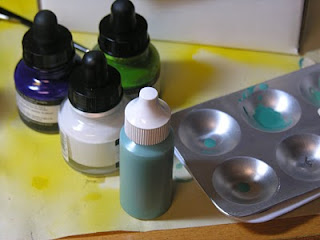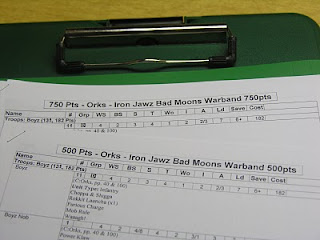Well we are full swing here at the university. I find myself behind on my blogging schedule. With that said I apologize for not making my one post every two weeks schedule, however I will say what I lack in quantity I will hope to make up for in quality. My paint time has been sparse however with my dedicated setup I have been able to make good progress. Today I will show you where I am with my Bad Moons Battlewagon.
As I have stated many times I am not a fan of the loud bright yellow some people favor by the same token I don't wanted an entirely muted yellow either. What I have recently worked on is brightening patches of the trucks armor. I use Vallejo Game Color Sunblast yellow for this. I load some on a number one brush and lightly let in flow into areas. I try to stay away from edges so they can keep their dark shading. On the very edge I use Vallejo Bad Moon Yellow I also use it on the top of bolts it creates a nice pop on the model and allows me to keep the grit below are some shots for you to see.
Not sure how well my pictures captures it but the body shows my technique the turret hasn't yet been treated with the exception of the bottom support struts. I really like the effect it looks like a real Ork vehicle but still has that loud yellow pop you expect from a Bad Moons vehicle.
Here you see the front of the wagon. I used the rust ink I mixed up in the last blog and added some of the armor wash recipe created by Les Bursley. Of the wash recipes offered by Les I used the armor wash the most. These are thicker inks that can create a glaze like effect. Another way to play with the recipes is to modify the amount of water and ink. I have used the self mixed inks and the Vallejo washes for various effects on the wagon.
Here you see one of my favorite features on the wagon. I got these rockets from Forgeworld. I painted the rocket with a Vallejo Game Color Yellow Olive. This rocket highlights one of my habits I like to purchase all avaliable colors because I never know when I might need them. For this rocket I sat for a bit of time looking through my colors to try and find the right one. This is also where color swatches come in handy. With all colors handy it was just a matter of finding the right one and from there the project moved on, no running to the hobby store to find a color.
Tires and Treads
After working on the body I wanted a break and decided to work on one side of tires and treads. Above is the treads with a basic paint of gun metal
Now these are the treads after a wash of armor wash and some forgeworld weathering pigments. I used a very pure form of Isopropyl alcohol to set the pigments. If you looking to get a dry crumbling look with pigments it won't happen in my opinion. Pigments are designed for more stationary models like a diorama. Once you start moving and handling the model the dry pigments will crumble. Using the alcohol sets the pigments and they some what dissolve what you get is this streaking look that I think still works. This is a good video quick video overview of what pigments can do. Now to get a good textured look of build up I went with a very solid product.
Here you see a dry mud on the treads I used this on the wheels as well. The product is Black Lava by Vallejo. This product is like a textured paste that has awesome applications. When it dries black it's basically primed. A few blogs have reviewed this product so I won't go into too much more detail, the links are here to the other blogs being Oni, Stahly's Paint Station, and PX40K. This is a great product you really should get a bottle today. I used it as well to fill in the skull pits on a realm of battle board but that's for another day.
Below you will see my tires which I painted in similar fashion to the treads. One of the added touches was to paint a blueish rust around the bolts that was created by mixing dark green and hawk turquoise. I like the effect and gives a good touch to the tires.
 |
| Tire painted flat without highlights or washes |
 |
| Finished tire with rust and dirt effects |
So there you have an update on the battlewagon and some examples of using a great product Vallejo's Black Lava. By the next entry we should be close to done with the Battlewagon. Thanks for reading and happy painting.
























































